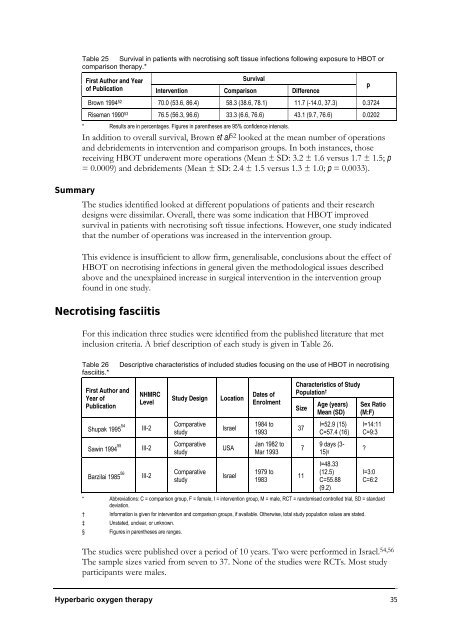Hyperbaric Oxygen Therapy - Hyperbaric Chamber Information ...
Hyperbaric Oxygen Therapy - Hyperbaric Chamber Information ...
Hyperbaric Oxygen Therapy - Hyperbaric Chamber Information ...
You also want an ePaper? Increase the reach of your titles
YUMPU automatically turns print PDFs into web optimized ePapers that Google loves.
Summary<br />
Table 25 Survival in patients with necrotising soft tissue infections following exposure to HBOT or<br />
comparison therapy.*<br />
First Author and Year<br />
of Publication Intervention<br />
Survival<br />
Comparison Difference<br />
p<br />
Brown 1994 52 70.0 (53.6, 86.4) 58.3 (38.6, 78.1) 11.7 (-14.0, 37.3) 0.3724<br />
Riseman 1990 53 76.5 (56.3, 96.6) 33.3 (6.6, 76.6) 43.1 (9.7, 76.6) 0.0202<br />
* Results are in percentages. Figures in parentheses are 95% confidence intervals.<br />
In addition to overall survival, Brown et al 52 looked at the mean number of operations<br />
and debridements in intervention and comparison groups. In both instances, those<br />
receiving HBOT underwent more operations (Mean ± SD: 3.2 ± 1.6 versus 1.7 ± 1.5; p<br />
= 0.0009) and debridements (Mean ± SD: 2.4 ± 1.5 versus 1.3 ± 1.0; p = 0.0033).<br />
The studies identified looked at different populations of patients and their research<br />
designs were dissimilar. Overall, there was some indication that HBOT improved<br />
survival in patients with necrotising soft tissue infections. However, one study indicated<br />
that the number of operations was increased in the intervention group.<br />
This evidence is insufficient to allow firm, generalisable, conclusions about the effect of<br />
HBOT on necrotising infections in general given the methodological issues described<br />
above and the unexplained increase in surgical intervention in the intervention group<br />
found in one study.<br />
Necrotising fasciitis<br />
For this indication three studies were identified from the published literature that met<br />
inclusion criteria. A brief description of each study is given in Table 26.<br />
Table 26 Descriptive characteristics of included studies focusing on the use of HBOT in necrotising<br />
fasciitis.*<br />
First Author and<br />
Year of<br />
Publication<br />
Shupak 1995 54<br />
Sawin 1994 55<br />
Barzilai 1985 56<br />
NHMRC<br />
Level<br />
III-2<br />
III-2<br />
III-2<br />
Study Design Location<br />
Comparative<br />
study<br />
Comparative<br />
study<br />
Comparative<br />
study<br />
Israel<br />
USA<br />
Israel<br />
Dates of<br />
Enrolment<br />
1984 to<br />
1993<br />
Jan 1982 to<br />
Mar 1993<br />
1979 to<br />
1983<br />
Characteristics of Study<br />
Population †<br />
<strong>Hyperbaric</strong> oxygen therapy 35<br />
Size<br />
37<br />
7<br />
11<br />
Age (years)<br />
Mean (SD)<br />
I=52.9 (15)<br />
C=57.4 (16)<br />
9 days (3-<br />
15) §<br />
I=48.33<br />
(12.5)<br />
C=55.88<br />
(9.2)<br />
Sex Ratio<br />
(M:F)<br />
I=14:11<br />
C=9:3<br />
?<br />
I=3:0<br />
C=6:2<br />
* Abbreviations: C = comparison group, F = female, I = intervention group, M = male, RCT = randomised controlled trial, SD = standard<br />
deviation.<br />
† <strong>Information</strong> is given for intervention and comparison groups, if available. Otherwise, total study population values are stated.<br />
‡ Unstated, unclear, or unknown.<br />
§ Figures in parentheses are ranges.<br />
The studies were published over a period of 10 years. Two were performed in Israel. 54,56<br />
The sample sizes varied from seven to 37. None of the studies were RCTs. Most study<br />
participants were males.



